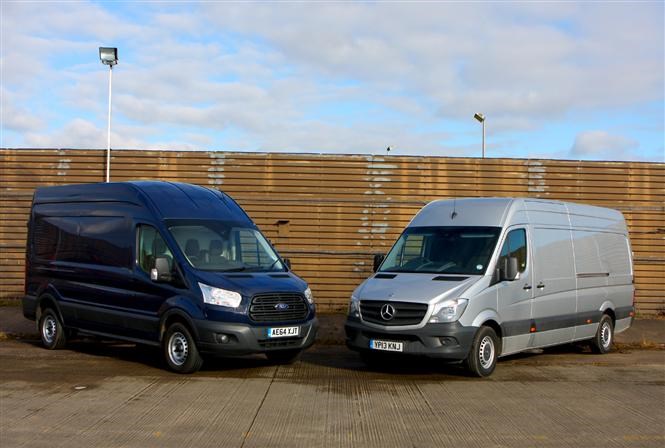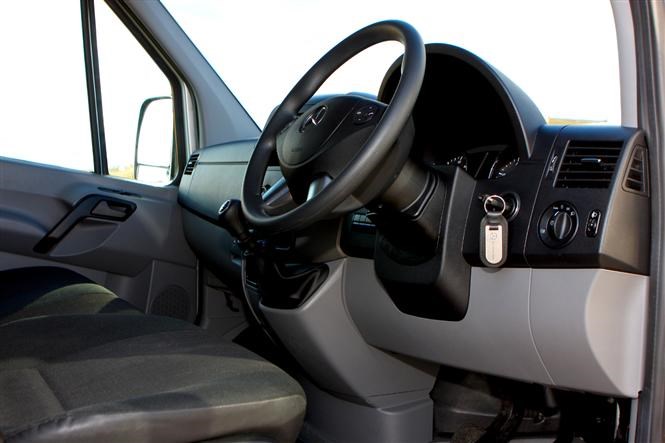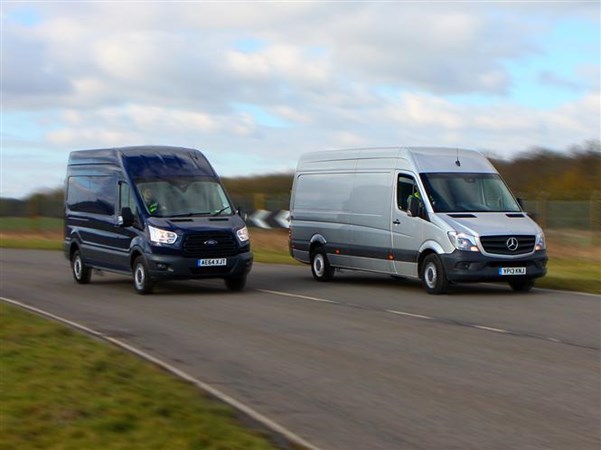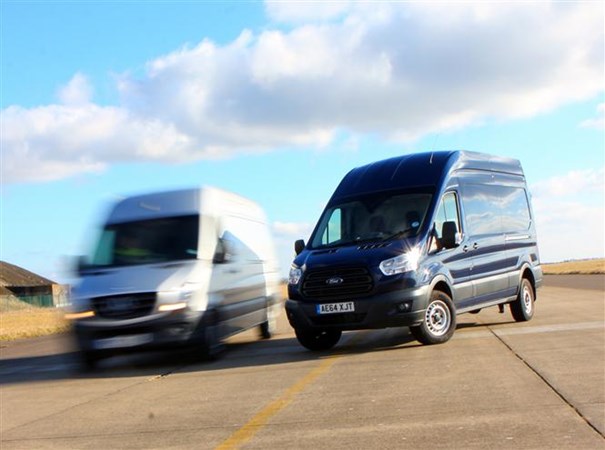Also read: Ford Transit Custom Sport v Vauxhall Vivaro Sportive
Also read: Volkswagen Caddy v Ford Transit Connect
When it comes to premium quality heavy vans, two names are head and shoulders above the rest. The Mercedes-Benz Sprinter and Ford Transit have long been two of the best-selling vans in this segment, but which van truly deserves to be crowned the ‘Best Heavy Van’?

In the cab
Cab comfort is playing an increasingly high role in purchasing trends for van buyers, and both vans scored well in this department. Ford has opted for the funky and stylish approach, while the Germans, as ever, have gone for smart and functional.

While there’s no doubt that the Transit has the more ‘fun’ and car-like cab, with the low seating position and eccentric infotainment system buttons, the Sprinter provides a lot more storage space and offers a much more commanding, elevated seating position and therefore has better all-round vision.

Both vehicles score equally on leg room, both for driver and passengers, and the amount of cupholders. The seats are more comfortable in the Transit and the glovebox is a lot deeper and more practical.
While the Transit is a lot quieter at speed, the grunt from the engine pulling away from traffic lights is far more noticeable than the Sprinter.
Winner: Tie
Load Area
As we move to the business end of the vehicle, the differences between the two become more apparent. The Mercedes-Benz Sprinter is certainly the more versatile, with four load lengths (2,700mm-4,800mm against 3,044mm-4,217mm), three roof heights (1,650mm-2,140mm against 1,886mm-2025mm), a broader load volume (7.5-17 cubic metres against 9.5-15.1 cubic metres) and gross vehicle weight range (3.3t-5.0t against 2.9t-4.7t).

While the Mercedes-Benz Sprinter offers a better maximum payload at 3.5 tonnes (1,478kg against 1,442kg; see Best 3.5t vans for payload for more information), the Ford Transit has a wider load width (1,784mm against 1,780mm) and width between the wheel arches (1,392mm against 1,350mm). The side load door widths are exactly the same at 1.3 metres.
Loading height was something we struggled with, though. As we can see on the images, the Mercedes-Benz Sprinter is much lower, but on record, the Transit is lower. This is because it has been calculated by measuring to the step, rather than the load floor, and therefore Mercedes-Benz is the winner here.
Winner: Mercedes-Benz Sprinter
On the road
The driving characteristics of the two heavyweights differ considerably, and again it’s the Ford Transit that demonstrates the more car-like characteristics than the utilitarian Mercedes-Benz Sprinter’s handling.

Whereas the Ford Transit has precise, car-like steering, the Sprinter feels less connected and tends to roll more in corners. That said, bumps and potholes are cushioned a lot better than the Transit.
In terms of performance, the 2.2-litre Transit and 2.1-litre Sprinter stack up fairly evenly, with the Sprinter achieving 129bhp and 305Nm or torque and the Transit reaching 123bhp and 350Nm. The Sprinter, however, performed the better thanks to wide torque and power bands.
Gear changes are smoother on the Transit, although the Sprinter has a more commanding driving position.
Winner: Ford Transit
Total Cost of Ownership
Nowadays, more and more operators are looking at cost over the life of the vehicle, rather than just the price at the bottom of the spec sheet.
The two are fairly evenly matched when it comes to price, with the Ford Transit at £21,145 and the Mercedes-Benz Sprinter at £21,075 on the official guides. However, on the Parkers For Sale section, there are some good deals on the Transit, costing about £14,990 plus VAT.

Sprinters, having been renowned for reliability and durability since their early days, enjoy the highest residual values in the sector though, which means you will benefit from higher prices by the time you come to sell.
There is nothing between the two when it comes to fuel consumption, with both entry models returning around 37.7mpg (Transit) and 38.7mpg (Sprinter), increasing to 44.4mpg (Sprinter Blue Efficiency) and 44.1mpg (Transit Econetic) on the fuel efficient variants.
Mercedes-Benz offers the best service intervals and warranty, at 37,500 miles or two years, and three year unlimited mileage, respectively. Ford offers a still respectable 30,000 miles or two year service interval and a three year, 100,000 mile warranty.
The Merc’s commercial vehicle dealer network may be slightly smaller than Ford’s new Transit24 network, but it offers 24/7 breakdown recovery to the nearest dealership, the repairs are guaranteed for three years (rather than the length of the original warranty), and 24 hour roadside assistance for 30 years.
Winner: Mercedes-Benz Sprinter
Summary
The Ford Transit is more fun to drive and has some great in-cab features, but the Mercedes-Benz retains its crown as “King of the Heavyweights” owing to its great aftersales support, reliability, total cost of ownership and productivity. These are the key areas that buyers find most useful when looking for a new van, but the competition from the Blue Oval isn’t far behind.
Winner: Mercedes-Benz Sprinter
Just so you know, we may receive a commission or other compensation from the links on this website - read why you should trust us.

